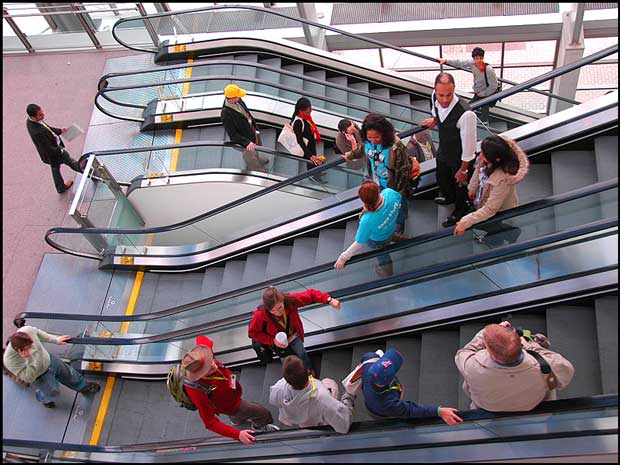
All escalators in Ontario are built with emergency stops as well as automatic safety features. Photo courtesy of jdn, via Flickr
By Kelly Townsend
A nightmare situation occured Thursday morning when a woman in Montreal was strangled as her scarf and hair were caught at the bottom of an escalator. She went into cardiac arrest and was declared dead by the time police arrived at the scene.
Most Canadians can recall their childhood fear of stepping onto an escalator and getting sucked into the moving stairs or caught in the continuously cycling handrail. However, once those fears have subsided, most will step onto them without thinking and run up or down to cut down a second or two of travel time.
The tragedy in Montreal has brought to light the real safety concerns of escalator use.
A Standstill in Escalator Design
Escalator design hasn’t been modified much since the original patent in 1892. An article from Popular Science, published in 2011, states that escalator engineers haven’t made any extensive changes to escalator design because there hasn’t been a demand for it.
David Chan, the director of the Centre for Information Leadership at City University in London, told Popular Science, “What’s in place is safe enough.”
Escalator Safety Precautions Are in Place
In an e-mail statement from The Technical Standards and Safety Authority (TSSA), Wilson Lee, the director of stakeholder relations, said escalators installed in the last ten years in Ontario have been required to include an automatic shutdown feature located at the top and bottom comb plate that will trigger when sufficient pressure is detected.
“This automatic shutdown feature is different from the stop button that requires someone to manually push the button to shut the escalator down,” Lee said in an e-mail statement to Humber News.
In their 2012/13 annual public safety performance report the TSSA stated that 370 injuries from escalators and moving walks were reported in the last fiscal year, three of which were considered serious. There have been no fatalities on record.
A study published by the West Journal of Emergency Medicine indicated that about 10,000 serious escalator-related injuries occur each year in the United States. The study concluded that there is a risk of serious physical trauma from escalator-related accidents.
Danny Nicholson, who works in public communications for the TTC, spoke with Humber News about their safety precaution procedures.
“The main thing we tell our customers is not to rush or run towards escalators,” He said. “Hold the handrails and let the escalator carry you up.”
Nicholson says that escalator maintenance at stations is done frequently. ”They’re checked every week and every so often they go under a major overhaul. Our escalators are kept in very good working condition.”
New Innovations in Escalators
Innovations have been proposed in escalator design over the last few years, however. Jack Levy, a professor in mechanical engineering at City University, teamed up with Chan to develop a single looping escalator, that moves between two staircases and levels into flat walkway, eliminating the need for a landing platform.
Levy and Chan’s escalator proposal, named the “Levytator”
There is no word as to whether the Levytator will become a mainstream design, but this tragic accident may be the pressure engineers need to push new innovations in escalator mechanics.

